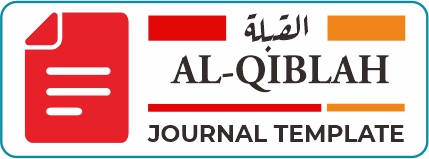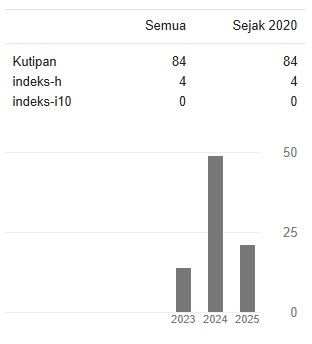Tinjauan Hukum Islam terhadap Tutup Kandungan Wanita dengan Alasan Pembatasan Keturunan (Kajian Perspektif Maslahah)
Review of Islamic Law on Covering a Woman's Womb for the Reason of Restricting Heredity (Maslahah Perspective Study)
DOI:
https://doi.org/10.36701/qiblah.v1i2.1605Keywords:
womb, woman, maslahahAbstract
This research aims to determine Islamic law regarding the closure of a woman's womb for reasons of limiting offspring (maslahah perspective study). This research uses a type of library study research, which focuses on the study of manuscripts and texts, using historical, normative and philosophical approach methods. The results of the research found are as follows: First, the concept of uterine closure or tubectomy according to health science, uterine closure is a process which is carried out by blocking the uterine tubes (fallopian tubes) to prevent the transfer of ovum to the uterine cavity and is achieved by cutting the tube, installing a clip or ring. In this process there are several impacts that will arise, there are short-term impacts that will be felt after the tubectomy process is carried out and also long-term impacts that will not be immediately felt by the woman who has the tubectomy or closure of the womb. Second, the view of Islamic law regarding the closure of a woman's womb for the reason of limiting heredity is that it is not permissible to cover the womb because it is contrary to human nature and also to Islamic law which has been established by Allah SWT. has appointed his servant with the best determination. Third, the Islamic view of covering a woman's womb for the reason of limiting offspring seen from the perspective of maṣlaḥah is contrary to maslahah itself. Because the purpose of enacting Islamic law is to benefit its adherents, it also maintains the goals of the law and prevents harm and closure of women's wombs, which is contrary to the goal of maṣlaḥah itself.
Downloads
References
Al-Dausiri, Muslim ibn Muhammad ibn Majid, al-Mumti’ fii al-Qaidah al-Fiqhiyyah Cet. I; Riyad: Dār al-Zidni, 2007 M/1428 H.
Al-Jāmi’ah, Lajnah I’dād al-Manāhij bii, Fiqh al-Nawāzil.
Al-Jamiyah al-Amrikiyyah al-Maftuhah, Fiqh al-Nawāzil.
Al-Rammani , Zaid ibn Muhammad, Maqāṣid al-syarī’ah al-Islamiyyah, Cet. I; Riyad: Dār al-Ghaisth, 1994 M/1415 H.
Al-Sa’di, Abdul al-Rahman ibn nāshir, Tasir al-Karim al-Rahman fii Tafsiri Kalām al-Mannān, Cet. II; Kairo: Dār al-‘amiyyah, 2016 M/1437 H.
Hambal, Ahmad bin Muhammad bin, al-Musnad,Juz 10. Cet. I; Kairo: Dār al- Hadits, 1995 M/1416 H.
Departemen Pendidikan, Kamus Besar Bahasa Indonesia , Jakarta: Pusat Bahasa, 2008.
“Departemen Pendidikan”, Kamus Besar Bahasa Indonesia Online. https://kbbi.web.id (25 Desember 2018)
Definisi Menurut Para Ahli “Pengertian Tubektomi pada Wanita”, Situs Resmi Definisi Para Ahli,http://www.definisimenurutparaahli.com/pengertian-tubektomi-pada-wanita/ (10 Mei 2019).
Fatah, Rohadi Abdul, Analisis Fatwa Keagamaan dalam Fikih Islam, Cet. I; Jakarta: PT Bumi Aksara 2006.
Forcepta Chania dan Rodiani. “The Factors that Use of Contraception Woman Medical Operation (WMO) on Childbearing Age”,Majority 6, no. 1 (2017): h. 11-17.
Fudah, Abdurrahman Muhammad, Jami’ Fatwa al- Ṭabib wa al-Marīḍ, terj. Irwan Raihan, Fatwa-fatwa Medis Kontenporer, Cet. I; Solo: Pustaka Arafah, 2011.
French, Kathy, Sexual Healt, terj. Bhetsy Agelina, Kesehatan Seksual , Jakarta: Bumi Medika, 2015.
Haq, Hamka, Filsafat Usul al-Fiqh, Makassar: Yayasan al-Ahkam, 1998.
Hasan, Cik Bikri, Model Penelitian Kitab Fikih Cet. I; Bogor: Kencana, 2003.
Honestdocs “Tubektomi: Kegunaan, Prosedur, Efek Samping”, Situs Resmi Honestdocs, http://www.honestdocs.id/tubektomi.amp (15 Mei 2019).
Kurdi, Muliadi, Muji Mulia, Problematika Fikih Modern, Banda Aceh: Yayasan Pena, 2005.
Muhammad ibn Hasiin al-Jaizãni, Fiqh al-Nawāzil, Juz 4. Cet. II; Kairo: Dār ibn al-Jauzi, 2006 M/1427 H.
PKMI, Dasar-Dasar Kontrasepsi Mantap Wanita, Jakarta: IBRD Loan, 3298 Indonesia, 1996.
Saifuddin, Abdul bari, Biran Afandi, Moh. Baharuddin, Soekaemi Soekir, Buku Panduan Praktis Pelayanan Kontrasepsi, Jakarta: Yayasan Bina Pustaka Sarwono Prawirohardjo, 2006.
Setyorini, Aniek, Kesehatan Reproduksi dan Pelayanan Keluarga Berencana Cet II; Bogor: In Media, 2016.
Soewadji, Jusuf, MA, Pengantar Metodologi Penelitian, Cet. I; Jakarta: Mitra Wacana Media, 2012.
Syarifuddin, Amir, Usul Fiqh, Cet I; Jakarta: Logos Wacana Ilmu, 1999.
Tempo.co, “Tahun Ini, Angka Kelahiran Jepang Catat Rekor Terendah Sejak 1899”, Situs Resmi Tempo. https://dunia.tempo.co/read/1157994/tahun-ini-angka-kelahiran-jepang-catat-rekor-terendah-sejak-1899
Umar, Hasbi, Nalar Fiqh Kontemporer, Cet. I; Jakarta: Gaung Persada Press, 2007.
Aziz, Abdul, Ensiklopedi Hukum Islam Cet III; Jakarta: Ichtiar Baru Van Hoeve, 1999.
Widodo, Metodologi Penelitian Popular Dan Praktis,Cet. I; Jakarta: Rajawali Pres, 2017.
Zuhdi, Musifuk, Kapita Selekta Hukum Islam, Jakarta: Haji Masagung, 1992.



 FOCUS AND SCOPE
FOCUS AND SCOPE EDITORIAL TEAM
EDITORIAL TEAM












